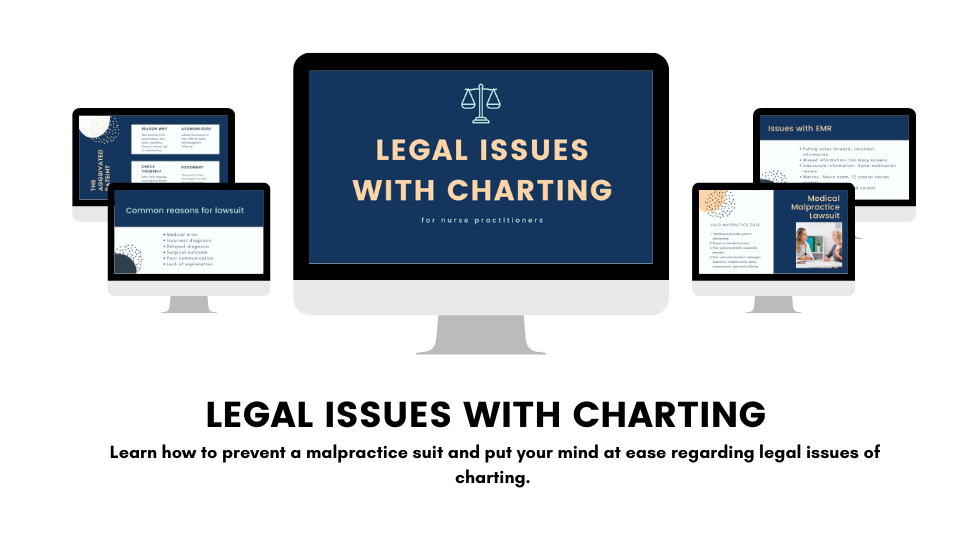Working as a nurse practitioner is a rewarding and fulfilling career. APRNs are in the perfect position to really make an impact in their patient’s lives. Nurse practitioners have the opportunity to help patients in their most vulnerable experiences.
But with this great responsibility comes great risk. If there is a negative outcome, it means the patient or family suffers a great loss. When dealing with stressful, serious situations, nurse practitioners are at great risk.
This increase of risk creates a need for protection through medical malpractice insurance for nurse practitioners. Malpractice insurance, also known as professional liability insurance, is a crucial aspect of a nurse practitioner’s career. This blog post aims to demystify malpractice insurance, outlining its importance, the various types available, and whether a separate policy is necessary for nurse practitioners.
***Full disclosure, I am not a lawyer nor do I pretend to be one! I am a family nurse practitioner and Nurse Practitioner Charting Coach who educates nurse practitioners about career related topics.
For more information on career and charting coaching, check out The Nurse Practitioner Charting School!
What is malpractice insurance for nurse practitioners?
Medical malpractice insurance is a specialized type of professional liability insurance designed to protect healthcare professionals, including nurse practitioners. Medical malpractice shield nurse practitioners from legal claims and financial losses arising due to alleged negligence, errors, or omissions in their practice.
In the medical field, mistakes can have serious consequences, making malpractice insurance essential for safeguarding both the nurse practitioner’s career and financial well-being. Becoming aware and ensuring you have a malpractice insurance policy in place is so important in your career as a nurse practitioner.
Types of malpractice insurance for nurse practitioners:
Below are the different types of medical malpractice insurance for nurse practitioners.
Occurrence-based malpractice insurance for nurse practitioners
Occurrence-based policies cover incidents that occur during the policy period, regardless of when the claim is filed. This type of insurance provides long-term protection, ensuring that even if a claim is made years after the incident, the nurse practitioner is covered if the incident happened while the policy was active. Occurrence-based policies are a great malpractice insurance for nurse practitioners.
Claims-made malpractice insurance for nurse practitioners
Claims-made policies cover claims made only while the policy is in effect. If a nurse practitioner switches to a different insurance provider or retires, they might need to purchase tail coverage, an additional policy that covers claims made after the original policy expires. Tail coverage can be expensive, making claims-made policies potentially costlier in the long run.
Occurrence-made malpractice insurance for nurse practitioners
This type of policy combines elements of both occurrence-based and claims-made insurance. It covers incidents that occur during the policy period and allows practitioners to report claims even after the policy has expired, provided the incident occurred while the policy was active.
Do nurse practitioners need a separate malpractice policy?
The question of whether nurse practitioners need a separate malpractice policy often depends on their employment status and the policies of their employers. Here are some scenarios to consider:
Employed nurse practitioners
Nurse practitioners employed by hospitals, clinics, or healthcare institutions are often covered under their employer’s malpractice insurance policy. However, it’s crucial for nurse practitioners to understand the extent of this coverage. Some employers might provide coverage that is limited in scope or may not cover certain specialized procedures. In such cases, nurse practitioners might consider purchasing additional coverage, often referred to as “tail coverage,” to ensure they are protected adequately.
Independent nurse practitioners
Nurse practitioners operating independent practices, working as locum tenens, or offering telemedicine services should definitely invest in their malpractice insurance policy. Being self-employed means they are solely responsible for their own liability. Having an individual malpractice insurance policy tailored to their specific practice area and patient population is essential to mitigate potential risks.
Nurse practitioners with occurrence-based coverage
Nurse practitioners covered under occurrence-based policies are generally protected even after they retire or change employers, provided the incident occurred during the policy period. In this case, they might not need a separate policy unless they want additional coverage for specific situations.
Nurse practitioners with claims-made coverage
Nurse practitioners with claims-made policies need to be cautious when changing jobs or retiring. Without purchasing tail coverage, they might be exposed to claims made after the policy expiration date. Therefore, in such cases, having a separate malpractice insurance policy or obtaining tail coverage is crucial to prevent potential legal and financial challenges down the road.
Find malpractice insurance for nurse practitioners
Finding medical malpractice insurance for nurse practitioners can feel overwhelming. If you simply google “malpractice insurance for nurse practitioners” you are bombarded with multiple different sites and ads promoting services.
I recommend nurse practitioners spend a little time finding a good medical malpractice insurance plan. There are several different sites that you can get quotes through. The quotes will be based on what type of nurse practitioner you are, years of experience, practice setting, and what you will be doing in that practice.
For example, a new grad nurse practitioner starting in an ER setting will have a different malpractice coverage than an experienced nurse practitioner who is starting their own aesthetics business.
Getting quotes from several different medical malpractice insurance companies is beneficial to making sure you get a solid plan. It may be beneficial to work with a medical malpractice insurance broker as they can help search different plans and guide you to the best option.
I also recommend nurse practitioners ensure that the plan covers what types of services they are providing. Nurse practitioners who are going to be doing aesthetics or hormone replacement may not be properly covered on a basic malpractice insurance for nurse practitioners. APRNs will want to make sure what they are doing is properly covered.
Here are a few different sites of medical malpractice insurance for nurse practitioners providers.
Nurse Service Organization (NSO)
Healthcare Providers Service Organization (HPSO)
Take a look at these websites and discover which one is best for you! Make sure to ask lots of questions and ensure the plan is right for your type of practice. Ensure you find the correct malpractice insurance for nurse practitioners plan that fits your professional practice.
Learn more about legal issues
In conclusion, malpractice insurance is a vital safeguard for nurse practitioners, protecting their careers and financial well-being from the complexities of the healthcare system. The type of policy needed depends on various factors, including employment status, policy coverage, type of practice, and future career plans.
Nurse practitioners must proactively assess their situation, understand their current coverage, and anticipate potential risks to make informed decisions about their malpractice insurance needs. Whether through their employer’s policy or a separate individual policy, having adequate malpractice insurance for nurse practitioners ensures that APRNs can focus on providing excellent patient care and provides peace of mind for the practitioners themselves.
To learn more about legal issues nurse practitioners face, check out The Legal Issues with Charting Course.

This online, self-study course will discuss:
- Common reasons healthcare providers get sued.
- What actually makes a valid malpractice case.
- The steps of a malpractice case.
- Charting tips and wording to use/avoid to prevent a malpractice case.
Learn more at: The Legal Issues with Charting Course

Erica D the NP is a family nurse practitioner and The Nurse Practitioner Charting Coach. Erica helps nurse practitioners STOP charting at home! Erica created The Nurse Practitioner Charting School to be the one stop for all documentation resources created specifically for nurse practitioners. Learn more at www.npchartingschool.com
Follow on Facebook: The Nurse Practitioner Charting SchoolAnd on Instagram: @npchartingschool
Free training: 4 charting tips to help nurse practitioners get their time back! Sign up here!



